Stock photos exist so you can easily select a professional image that’s already out there for your material. They offer universal convenience and can save time. But they can also be impersonal.
Real photos—or photos produced specifically for your product/brand—can be time consuming and require more planning. But the end result is a photo that represents your unique brand in a way a stock photo just can’t.
Let’s look at how stock photos stack up to real, custom photos so you can choose which is best for your brand.
What are stock photos?
A stock photo is a photo produced for broad and generic use. it typically comes from a searchable gallery where it can be purchased or downloaded for use. In simple terms, someone else took a photo of a certain subject and you can use it in your marketing materials—but it won’t be original.
Reasons companies use stock photography
Stock images are a great option for companies to add to their content marketing mix. Though they’re not unique, they still offer many benefits for brands looking to boost their image.
Affordability
Stock photos might be a cheaper option. You can find free stock photos under a Creative Commons license, purchase stock images for business use, or subscribe to a website that allows you to access as many of its stock photos as you’d like. Any of these options would be cheaper than purchasing a new camera, backdrop, props, lighting, etc.—not to mention organize a whole lifestyle photography shoot with models.
Immediate access to photos
When you purchase the rights to use a stock photo, you typically have access to download or use it immediately. This means you don’t have to wait for post-production editing to start creating content with your photos. Editing software and platforms like Canva have even started to incorporate stock photos into their media libraries and offerings.
The cons of using stock images
Lacking originality
Stock photos are intended to be used by the masses. There won’t be any details that make the subject of the photo unique. Using stock photos may also make your website or social media feed appear generic. For example, you can’t even select which background you want to use.
Twinning with your competition
Even though there are tons of thousands to choose from, sometimes a stock photo gets so popular that multiple businesses use them. If a potential customer sees your brand is using the same stock photos as another brand, it looks insincere and lazy. You may be losing customer trust by having images that look too generic.
Think of when you’re shopping on Amazon and you come across a product that has the exact same photo for every product image, just with the color edited. You feel like you’re not actually seeing the true product and therefore it’s difficult to trust. When it comes to online brands, building trust with customers is so important!
{{studio-ad}}
Confusing licenses
Unless you have a very clear understanding of the license and usage laws around images, you may cause yourself headaches trying to puzzle out what you’re allowed to use for which project or purpose. A mistake in the legal realm can really cost you and your business. Look to get a license for royalty free images to use any photos to promote your business.
Stock photo 101: Licenses
It’s important to know which licenses apply to stock photos so you can avoid any financial or legal mishaps. Let’s break it down:
- Creative Commons (CC) licenses: Some photographers and image creators release their work under Creative Commons licenses. These licenses vary but often allow for free use of the images with some conditions, such as attribution or non-commercial use.
- Public domain: Images in the public domain aren’t protected by copyright and are free for all uses and purposes without a license or permission.
- Commercial use: Commercial licenses allow you to use the image for promotional or commercial purposes, such as in advertisements, brochures, or on products.
- Editorial use only: Some stock photos are licensed for editorial uses only. This means you can use them in news articles, blogs, or educational materials, but not for commercial purposes or advertising.
- Non-exclusive license: A non-exclusive license means the image can be licensed and used by multiple parties. It’s a more cost-effective option, but you won’t have exclusive rights to the image.
- Exclusive license: An exclusive license grants you exclusive rights to use an image. This means the image won’t be sold to others during the exclusivity period, giving you a unique and exclusive visual asset.
- Extended licenses: Some stock agencies offer extended licenses for specific uses that go beyond the standard terms. This might include using the image on merchandise or a sign, in TV or film, or for larger print runs.
- Royalty free (RF): A royalty free license allows you to pay for the image once and then use it multiple times without additional fees. However, there may still be restrictions on how you can use royalty free images, including limitations on print runs or distribution.
- Rights-managed (RM): Rights-managed licenses are more specific and usually come with limitations on usage, duration, and distribution. The cost of using an image is determined based on factors like the intended use, size, and reach of the audience.
Always check the specific terms and conditions associated with each image you intend to use. Understanding the licensing terms helps make sure you use stock photos in compliance with copyright and licensing requirements.
What are real photos or real images?
We use the term “real photos” here to describe photos that were produced specifically for your brand and content. They’re unique to you and you won’t find them anywhere else.

Reasons companies benefit from using real photos
If you want the best of the best, real photos is the way to go. Saying goodbye to stock should be the goal for every e-commerce brand. Here’s why:
Higher association of ownership and trust
We've all seen the weird duplicate effect on Amazon. You search for a product and there are five brands selling an eerily similar thing, even with similar product photos. It’s hard to trust those brands. When your images are unique to your brand, customers invest their time, attention, and trust into that product knowing that you invested your time, attention, and effort into creating the images!
Higher conversion (especially for images with people)

Research suggests that featuring humans (specifically facial features) in photos builds trust and emotional connections with shoppers. Taking the time to not only create high-quality product photos unique to your brand, but also employ model(s) may pay off in conversion.
Check it out: Models vs. mannequins: which is best for product photos? >
Customers value real photos in e-comm
Images showing detail and providing specific product information will capture people’s attention. Online shoppers are pretty well-trained on detecting a stock image. They tend to overlook images that are used for “fluff” (like a generic woman smiling) and spend more time looking at images that give them info (if that woman is wearing your product to show how it fits).
Collaborate with talent
Here at soona, we think this is the best part of “real photography”—you get to work closely with an expert photographer in real-time to create exactly the content you want. Creating a shot list gives your photographer a clear idea of what you want and gives you total creative freedom. photographers who specialize in product photography are 🪄magicians🪄 in the studio.

More creative control
Product and brand photography have many uses, and you’ll want to repurpose these content assets to maximize your return on investment (ROI). In order to do that, you need the perfect shot. And we all know that sometimes there is no perfect shot no matter how much time you spend browsing stock photography galleries.

Because real photos allow you to offer creative and strategic direction and even be on site should you choose, you get more control over the final look. You can come up with a shot list, you can test different angles and frames on set, and you can dictate the overall look and feel of the shots.
The cons of using real photos
It can be a lot of work
You may have a high-quality camera and the equipment to create a set already. If you want a DIY photo shoot you can also rent equipment from photography studios. Your third option is to hire a studio to take the photos for you.
Pro tip: soona offers you a chance to sit in on a virtual photo shoot in real-time—giving feedback as you go—and only purchasing the images you’re thrilled with!
It can be time-consuming
Successful photo shoots require a lot of planning. Before you even start shooting, collect and organize all the products you’ll be capturing, making sure everything is clean and blemish-free. Get the background, 👏 lighting, 👏 and props ready to go.
Once it’s time to start shooting, you may have to designate multiple hours to get each angle and style of shot you’d like. It can be an all-day affair! Having a studio like soona to collaborate with you can save you tons of time (and leg work).
It can get pricey!
Compared to stock photos, professional or DIY product photos can be expensive. The price can vary wildly! It really depends on the number of photos, type of props, and quality of equipment. It's important to note that high-quality product photos are an investment that pay off. These are the photos that represent your brand and product: you pay for them upfront and then see the benefits of brilliant product photography through product sales and customer loyalty!
{{stock-photo-blog-post}}
Work with soona to create unique product photos
So you’re ready to take the plunge and invest in some high-quality product photography that’s unique to your brand? Check out soona—you’ll be able to collaborate with incredible studio professionals in a virtual photo shoot while watching your vision come to life in real-time! Photos start at only $39 plus a monthly subscription or a one-time booking fee. You only purchase the photos you 💕 LOVE 💕.
{{studio-ad}}
Stock images FAQ
What are the sources that can be used for stock images?
- Shutterstock
- Unsplash
- Pixabay
- iStock
- Pexels
Are stock images high quality?
Some stock images are high quality while others may not be up to your quality standards. Most paid stock imagery is high quality, though this varies depending on the photo. It’s always best to do a quality check yourself before making a purchase or using a free stock image.
What are the disadvantages of stock images?
- They can be forgettable and un-impressionable.
- Other businesses may use the same stock image.
- You have less creative control over the image.
- It’s difficult to know if the image needs to be licensed for business use.
Is it OK to use stock photos?
Yes, it’s OK to use stock photos in your content marketing mix. It’s always best to balance stock images with real, custom brand and product photos. You can also use stock photography to create composite images.
Are people in stock photos real?
Yes, people in stock photos are real. However, especially with the rise of AI, some stock images use artificially generated people.
Stock photos exist so you can easily select a professional image that’s already out there for your material. They offer universal convenience and can save time. But they can also be impersonal.
Real photos—or photos produced specifically for your product/brand—can be time consuming and require more planning. But the end result is a photo that represents your unique brand in a way a stock photo just can’t.
Let’s look at how stock photos stack up to real, custom photos so you can choose which is best for your brand.
What are stock photos?
A stock photo is a photo produced for broad and generic use. it typically comes from a searchable gallery where it can be purchased or downloaded for use. In simple terms, someone else took a photo of a certain subject and you can use it in your marketing materials—but it won’t be original.
Reasons companies use stock photography
Stock images are a great option for companies to add to their content marketing mix. Though they’re not unique, they still offer many benefits for brands looking to boost their image.
Affordability
Stock photos might be a cheaper option. You can find free stock photos under a Creative Commons license, purchase stock images for business use, or subscribe to a website that allows you to access as many of its stock photos as you’d like. Any of these options would be cheaper than purchasing a new camera, backdrop, props, lighting, etc.—not to mention organize a whole lifestyle photography shoot with models.
Immediate access to photos
When you purchase the rights to use a stock photo, you typically have access to download or use it immediately. This means you don’t have to wait for post-production editing to start creating content with your photos. Editing software and platforms like Canva have even started to incorporate stock photos into their media libraries and offerings.
The cons of using stock images
Lacking originality
Stock photos are intended to be used by the masses. There won’t be any details that make the subject of the photo unique. Using stock photos may also make your website or social media feed appear generic. For example, you can’t even select which background you want to use.
Twinning with your competition
Even though there are tons of thousands to choose from, sometimes a stock photo gets so popular that multiple businesses use them. If a potential customer sees your brand is using the same stock photos as another brand, it looks insincere and lazy. You may be losing customer trust by having images that look too generic.
Think of when you’re shopping on Amazon and you come across a product that has the exact same photo for every product image, just with the color edited. You feel like you’re not actually seeing the true product and therefore it’s difficult to trust. When it comes to online brands, building trust with customers is so important!
{{studio-ad}}
Confusing licenses
Unless you have a very clear understanding of the license and usage laws around images, you may cause yourself headaches trying to puzzle out what you’re allowed to use for which project or purpose. A mistake in the legal realm can really cost you and your business. Look to get a license for royalty free images to use any photos to promote your business.
Stock photo 101: Licenses
It’s important to know which licenses apply to stock photos so you can avoid any financial or legal mishaps. Let’s break it down:
- Creative Commons (CC) licenses: Some photographers and image creators release their work under Creative Commons licenses. These licenses vary but often allow for free use of the images with some conditions, such as attribution or non-commercial use.
- Public domain: Images in the public domain aren’t protected by copyright and are free for all uses and purposes without a license or permission.
- Commercial use: Commercial licenses allow you to use the image for promotional or commercial purposes, such as in advertisements, brochures, or on products.
- Editorial use only: Some stock photos are licensed for editorial uses only. This means you can use them in news articles, blogs, or educational materials, but not for commercial purposes or advertising.
- Non-exclusive license: A non-exclusive license means the image can be licensed and used by multiple parties. It’s a more cost-effective option, but you won’t have exclusive rights to the image.
- Exclusive license: An exclusive license grants you exclusive rights to use an image. This means the image won’t be sold to others during the exclusivity period, giving you a unique and exclusive visual asset.
- Extended licenses: Some stock agencies offer extended licenses for specific uses that go beyond the standard terms. This might include using the image on merchandise or a sign, in TV or film, or for larger print runs.
- Royalty free (RF): A royalty free license allows you to pay for the image once and then use it multiple times without additional fees. However, there may still be restrictions on how you can use royalty free images, including limitations on print runs or distribution.
- Rights-managed (RM): Rights-managed licenses are more specific and usually come with limitations on usage, duration, and distribution. The cost of using an image is determined based on factors like the intended use, size, and reach of the audience.
Always check the specific terms and conditions associated with each image you intend to use. Understanding the licensing terms helps make sure you use stock photos in compliance with copyright and licensing requirements.
What are real photos or real images?
We use the term “real photos” here to describe photos that were produced specifically for your brand and content. They’re unique to you and you won’t find them anywhere else.

Reasons companies benefit from using real photos
If you want the best of the best, real photos is the way to go. Saying goodbye to stock should be the goal for every e-commerce brand. Here’s why:
Higher association of ownership and trust
We've all seen the weird duplicate effect on Amazon. You search for a product and there are five brands selling an eerily similar thing, even with similar product photos. It’s hard to trust those brands. When your images are unique to your brand, customers invest their time, attention, and trust into that product knowing that you invested your time, attention, and effort into creating the images!
Higher conversion (especially for images with people)

Research suggests that featuring humans (specifically facial features) in photos builds trust and emotional connections with shoppers. Taking the time to not only create high-quality product photos unique to your brand, but also employ model(s) may pay off in conversion.
Check it out: Models vs. mannequins: which is best for product photos? >
Customers value real photos in e-comm
Images showing detail and providing specific product information will capture people’s attention. Online shoppers are pretty well-trained on detecting a stock image. They tend to overlook images that are used for “fluff” (like a generic woman smiling) and spend more time looking at images that give them info (if that woman is wearing your product to show how it fits).
Collaborate with talent
Here at soona, we think this is the best part of “real photography”—you get to work closely with an expert photographer in real-time to create exactly the content you want. Creating a shot list gives your photographer a clear idea of what you want and gives you total creative freedom. photographers who specialize in product photography are 🪄magicians🪄 in the studio.

More creative control
Product and brand photography have many uses, and you’ll want to repurpose these content assets to maximize your return on investment (ROI). In order to do that, you need the perfect shot. And we all know that sometimes there is no perfect shot no matter how much time you spend browsing stock photography galleries.

Because real photos allow you to offer creative and strategic direction and even be on site should you choose, you get more control over the final look. You can come up with a shot list, you can test different angles and frames on set, and you can dictate the overall look and feel of the shots.
The cons of using real photos
It can be a lot of work
You may have a high-quality camera and the equipment to create a set already. If you want a DIY photo shoot you can also rent equipment from photography studios. Your third option is to hire a studio to take the photos for you.
Pro tip: soona offers you a chance to sit in on a virtual photo shoot in real-time—giving feedback as you go—and only purchasing the images you’re thrilled with!
It can be time-consuming
Successful photo shoots require a lot of planning. Before you even start shooting, collect and organize all the products you’ll be capturing, making sure everything is clean and blemish-free. Get the background, 👏 lighting, 👏 and props ready to go.
Once it’s time to start shooting, you may have to designate multiple hours to get each angle and style of shot you’d like. It can be an all-day affair! Having a studio like soona to collaborate with you can save you tons of time (and leg work).
It can get pricey!
Compared to stock photos, professional or DIY product photos can be expensive. The price can vary wildly! It really depends on the number of photos, type of props, and quality of equipment. It's important to note that high-quality product photos are an investment that pay off. These are the photos that represent your brand and product: you pay for them upfront and then see the benefits of brilliant product photography through product sales and customer loyalty!
{{stock-photo-blog-post}}
Work with soona to create unique product photos
So you’re ready to take the plunge and invest in some high-quality product photography that’s unique to your brand? Check out soona—you’ll be able to collaborate with incredible studio professionals in a virtual photo shoot while watching your vision come to life in real-time! Photos start at only $39 plus a monthly subscription or a one-time booking fee. You only purchase the photos you 💕 LOVE 💕.
{{studio-ad}}
Stock images FAQ
What are the sources that can be used for stock images?
- Shutterstock
- Unsplash
- Pixabay
- iStock
- Pexels
Are stock images high quality?
Some stock images are high quality while others may not be up to your quality standards. Most paid stock imagery is high quality, though this varies depending on the photo. It’s always best to do a quality check yourself before making a purchase or using a free stock image.
What are the disadvantages of stock images?
- They can be forgettable and un-impressionable.
- Other businesses may use the same stock image.
- You have less creative control over the image.
- It’s difficult to know if the image needs to be licensed for business use.
Is it OK to use stock photos?
Yes, it’s OK to use stock photos in your content marketing mix. It’s always best to balance stock images with real, custom brand and product photos. You can also use stock photography to create composite images.
Are people in stock photos real?
Yes, people in stock photos are real. However, especially with the rise of AI, some stock images use artificially generated people.
























